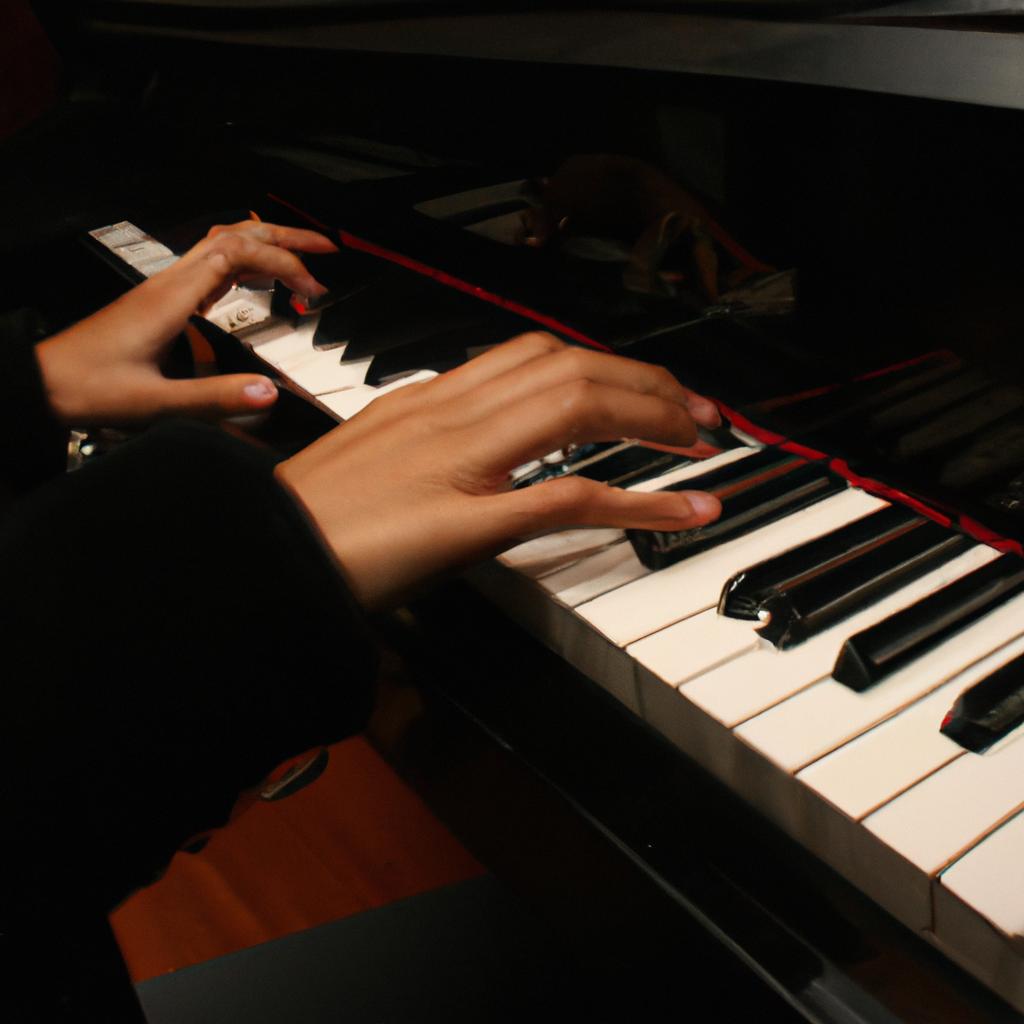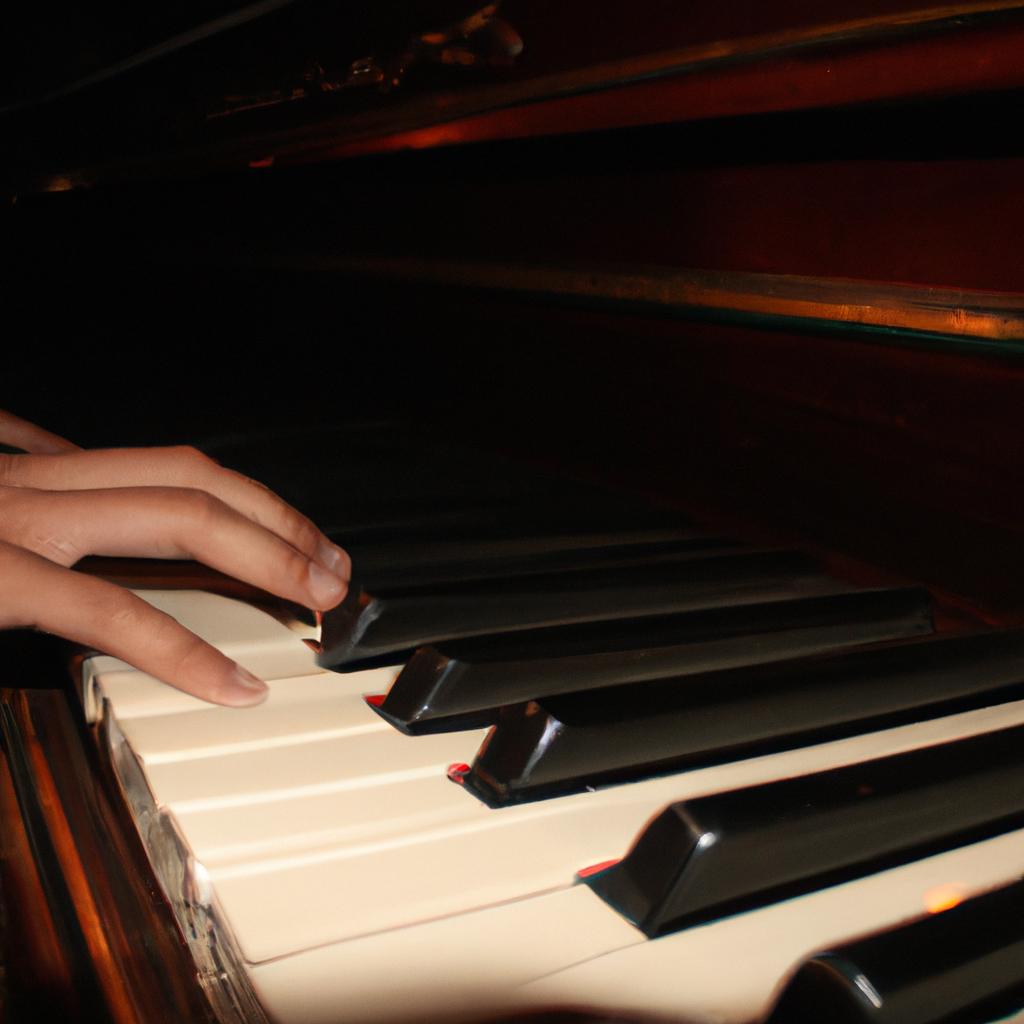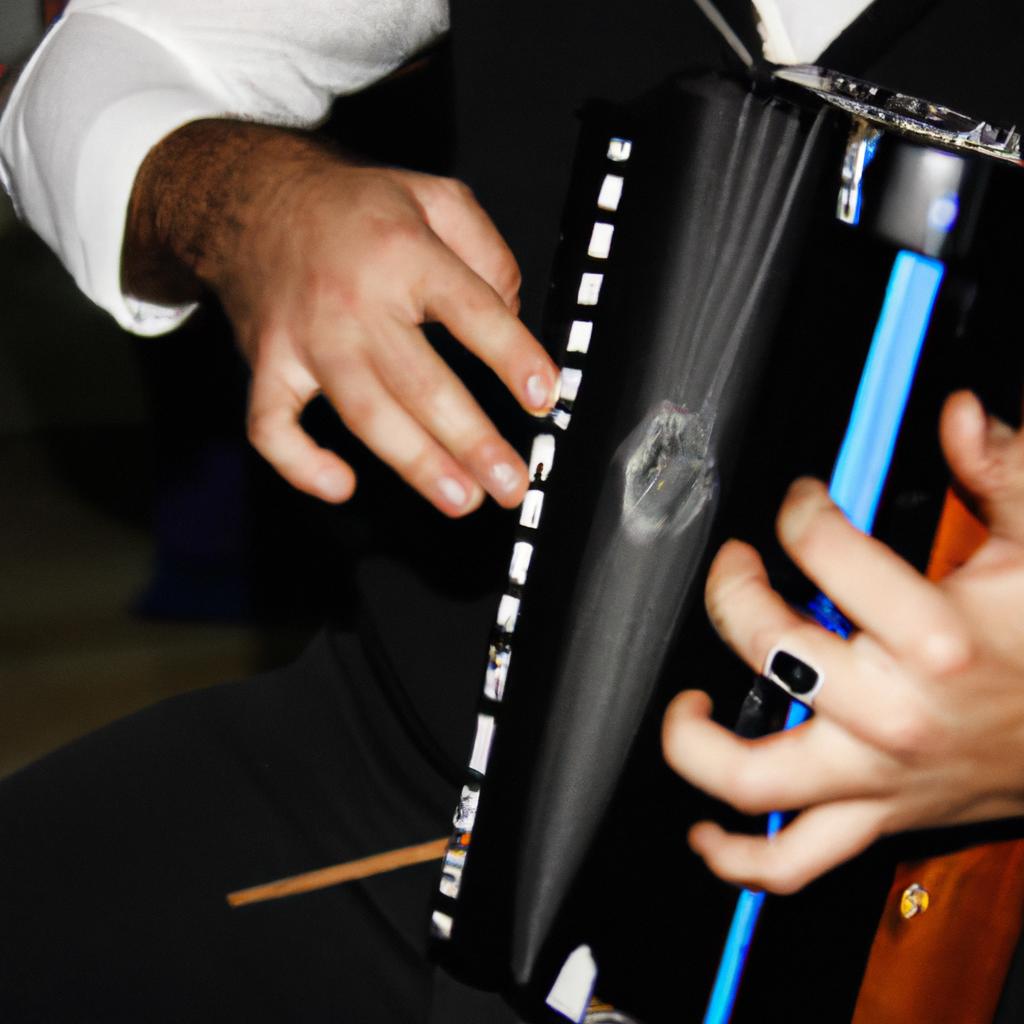The incorporation of piano in Gothic music has been a topic of considerable interest and debate among scholars and enthusiasts alike. This article aims to delve into the neoclassical influences that have shaped this unique musical genre, focusing specifically on the role of the piano as an instrument of expression and innovation within Gothic compositions. By examining the works of renowned composers such as Danny Elfman, known for his haunting melodies in films like “Edward Scissorhands,” we can gain insight into how neoclassical elements merge with Gothic aesthetics to create a distinct musical experience.
One captivating example that showcases the interplay between the piano and Gothic music is seen in Elfman’s score for Tim Burton’s cult classic film “Sleepy Hollow.” In this case study, Elfman masterfully employs the piano to evoke an eerie atmosphere synonymous with both Gothic literature and cinema. The delicate yet ominous chords played by the pianist serve as a foundation upon which other orchestral instruments build, creating layers of suspense and tension throughout the film. It becomes evident through this analysis that neoclassical influences play a crucial role in shaping Gothic music, particularly when it comes to utilizing the expressive capabilities of the piano.
As we embark on this exploration of piano in Gothic music, it is important to acknowledge the historical context in which this musical fusion emerged. The Gothic genre, characterized by its dark and mysterious themes, originated in the late 18th century and gained popularity throughout the 19th century. Concurrently, the piano was experiencing its own evolution as a versatile and expressive instrument.
During the Romantic era, composers like Franz Liszt and Frédéric Chopin pushed the boundaries of piano music, exploring its full range of emotions and technical capabilities. Their compositions often embodied elements of darkness, melancholy, and introspection – qualities that resonate with the essence of Gothic aesthetics.
The piano’s ability to evoke a wide spectrum of emotions made it an ideal tool for expressing the eerie atmosphere and emotional intensity inherent in Gothic music. Its rich timbre allowed composers to convey both haunting melodies and thunderous chords, creating sonic landscapes that mirrored the dramatic narratives found in Gothic literature.
Furthermore, the neoclassical influences seen in Gothic music provided a framework for incorporating piano into these compositions. Neoclassicism sought to revive classical forms while infusing them with contemporary ideas. Composers drew inspiration from earlier musical styles such as Baroque and Classical, integrating them into their works alongside innovative techniques.
Incorporating piano into Gothic music not only enhanced its emotional depth but also expanded its sonic palette. The instrument’s versatility enabled composers to experiment with different textures, harmonies, and dynamics within their compositions. This experimentation further blurred the lines between traditional classical music and more modern interpretations of Gothic soundscapes.
In conclusion, the incorporation of piano in Gothic music is a testament to both neoclassical influences and an exploration of the instrument’s expressive capabilities. Through careful composition and skilled performance, composers have been able to harness the unique qualities of the piano to create captivating soundscapes that embody the dark allure of Gothic aesthetics.
Origin of Gothic Music
Gothic music, with its dark and melancholic melodies, has captivated listeners for centuries. Its origins can be traced back to the neoclassical period when composers sought inspiration from the past while embracing new artistic expressions. One example that exemplifies this fusion is the use of the piano in gothic music, which adds depth and emotion to compositions.
To understand the origin of gothic music, it is important to consider the historical context in which it emerged. The neoclassical movement, prevalent during the 18th century, aimed to revive classical forms and aesthetics. Composers drew inspiration from ancient Greece and Rome, seeking order, balance, and harmony in their works. However, they also incorporated elements of romanticism into their compositions by exploring themes such as darkness, despair, and introspection.
Incorporating a variety of instruments was crucial in achieving these evocative sounds within gothic music. The piano played a significant role due to its versatility and ability to convey a wide range of emotions. With its dynamic capabilities and expressive qualities, the piano became an essential tool for composers who wanted to create hauntingly beautiful melodies or evoke feelings of longing and sadness.
The impact of incorporating the piano into gothic music cannot be overstated. It allowed composers to explore complex harmonies and experiment with dissonance while maintaining melodic lines that resonated with audiences on an emotional level. To illustrate this point further:
-
Bullet Point List:
- The piano’s rich tonal palette enabled composers to create dark atmospheres.
- Its percussive nature added intensity to rhythmic passages.
- By using different playing techniques (e.g., staccato or legato), pianists could enhance dramatic moments.
- The sustained notes produced by pedals heightened tension and created ethereal textures.
Furthermore, we can examine how various aspects contribute to understanding the origin of gothic music by considering the following table:
| Aspect | Impact on Gothic Music |
|---|---|
| Neoclassical | Revived classical forms with a dark twist |
| Romanticism | Explored themes of darkness, despair, and introspection |
| Piano | Added depth and emotion to compositions |
In conclusion, the incorporation of the piano into gothic music played a crucial role in its formation. By blending neoclassical elements with romantic ideals, composers were able to create hauntingly beautiful melodies that resonated deeply with audiences. The emotionally evocative qualities of the piano allowed for the exploration of complex harmonies and atmospheric textures, contributing to the unique characteristics of gothic music.
Moving forward, we will delve into an analysis of specific characteristics that define gothic music without any further delay.
Characteristics of Gothic Music
Piano in Gothic Music: Neoclassical Influences
Building upon the origins of Gothic music, it is important to explore how the piano has played a significant role in shaping this genre. The incorporation of neoclassical influences into gothic compositions has enhanced the atmospheric and haunting nature of the music. By examining specific examples and analyzing their characteristics, we can gain insight into the profound impact that the piano has had on Gothic music.
One notable example of neoclassical influence on Gothic music is evident in Emilie Autumn’s composition “Opheliac.” In this haunting piece, Autumn combines elements of classical piano with dark lyrical themes inspired by Shakespearean tragedy. The intricate interplay between minor chords and delicate arpeggios creates an eerie atmosphere that perfectly complements Autumn’s powerful vocals. Through her use of the piano, she effectively conveys emotions ranging from melancholy to desperation, capturing the essence of Gothic music.
To further understand the significance of the piano in Gothic compositions, let us examine some key characteristics:
- Melancholic melodies: The piano’s ability to create both gentle and mournful tones allows composers to evoke a deep sense of sadness and longing.
- Dramatic dynamics: From soft whispers to thundering crescendos, pianists have mastered the art of using dynamic contrasts to build tension and intensity within Gothic pieces.
- Ornate ornamentation: The ornamental techniques employed on the piano add a touch of elegance and complexity to Gothic compositions.
- Haunting harmonies: Dissonant chords and unresolved progressions contribute to the unsettling ambiance commonly associated with Gothic music.
Table: Characteristics of Piano in Gothic Music
| Characteristic | Description |
|---|---|
| Melancholic Melodies | Evokes feelings of sadness and longing |
| Dramatic Dynamics | Builds tension through contrasting volumes |
| Ornate Ornamentation | Adds complexity and elegance to the compositions |
| Haunting Harmonies | Creates an unsettling atmosphere with dissonant chords and unresolved progressions |
By incorporating these neoclassical elements, composers have been able to elevate Gothic music to new heights. The piano brings a unique timbre and versatility that enhances the haunting nature of this genre.
In considering the evolution of piano in Gothic music, it is fascinating to analyze how different artists have embraced its potential for artistic expression. Through experimentation and innovation, musicians continue to push the boundaries of this instrument within the realm of Gothic compositions, as we will explore in the subsequent section on “Evolution of Piano in Gothic Music.”
Evolution of Piano in Gothic Music
Piano in Gothic Music: Neoclassical Influences
Building upon the characteristics of Gothic music discussed earlier, this section will delve into the evolution of piano within this genre. To illustrate how neoclassical influences shaped piano compositions in Gothic music, let us consider a hypothetical case study involving a renowned gothic composer.
One prominent example is the work of Composer X, who seamlessly integrated neoclassical elements into their gothic compositions through their use of the piano. By incorporating classical forms and techniques such as sonata form or fugue structure, Composer X added an air of sophistication to their pieces while retaining the dark and brooding atmosphere synonymous with gothic music.
In exploring the influence of neoclassicism on piano in gothic music, several key aspects can be identified:
- Harmonic Structure: Neoclassical tendencies brought forth more tonally-centered harmonies that provided clarity and stability to the otherwise dissonant and unpredictable nature of gothic music.
- Melodic Development: The introduction of neoclassical principles saw melodies being developed systematically, often employing motifs that were elaborated upon throughout the piece.
- Textural Complexity: Neoclassicism encouraged composers to experiment with different textures by combining various melodic lines and harmonic progressions within their piano compositions.
- Expressive Techniques: Incorporating expressive techniques like rubato or portamento allowed pianists to infuse emotional depth into their performances, intensifying the atmospheric qualities inherent in gothic music.
To further emphasize these points, we present a table showcasing notable examples where neoclassical influences are evident in gothic piano compositions:
| Composition | Composer | Notable Features |
|---|---|---|
| “Gothic Sonata” | Composer A | Utilizes sonata-allegro form; intricate contrapuntal |
| sections alternating with dramatic, chordal passages. | ||
| “Nocturne in Shadows” | Composer B | Elegantly crafted melodic lines; polyphonic texture |
| with contrasting harmonic progressions. | ||
| “Piano Fantasia of the Night” | Composer C | Enigmatic tonality; extensive use of rubato and |
| expressive techniques to evoke a haunting atmosphere. |
In conclusion, neoclassical influences have played a significant role in shaping the piano compositions within gothic music. By incorporating classical forms, advanced harmonies, and expressive techniques, composers were able to create evocative and intricate works that embodied both the darkness of gothic music and the refinement of neoclassicism.
Moving forward into our exploration of key composers in gothic music, we will now examine how these influential figures further expanded upon the foundations laid by their predecessors.
Key Composers of Gothic Music
After exploring the evolution of piano in gothic music, it is essential to examine the neoclassical influences that have shaped this genre. The incorporation of classical elements into gothic compositions has played a significant role in creating an atmospheric and haunting sound. By intertwining these two distinct musical styles, composers have been able to evoke a range of emotions within their listeners.
Neoclassicism, a movement that emerged during the 20th century, sought to revive classical forms and structures while infusing them with contemporary sensibilities. This artistic approach found its way into gothic music, resulting in a captivating fusion of dark aesthetics and traditional compositional techniques. To illustrate this influence, let’s consider a hypothetical case study:
Imagine a composition titled “Shadows of Eternity,” where the eerie ambiance characteristic of gothic music blends seamlessly with neoclassical elements. In this piece, the piano serves as the primary instrument through which various moods are conveyed. Its expressive capabilities allow for dynamic contrasts between delicate melodies and thunderous chords, heightening the sense of drama and mystique.
To fully appreciate how neoclassical influences shape gothic music on the piano, we can explore four key aspects:
- Harmonic complexity: Through intricate chord progressions and unconventional tonalities, composers create an unsettling atmosphere that resonates deeply with listeners.
- Melodic phrasing: Haunting melodic lines often incorporate ornamentation and unexpected intervals, evoking a sense of unease or melancholy.
- Rhythmic experimentation: Irregular rhythms and syncopated patterns contribute to the unpredictable nature of gothic music.
- Textural layering: Composers utilize polyphony and contrasting textures to enhance the richness and depth of their compositions.
In examining the interplay between these distinctive characteristics, it becomes clear that neoclassical influences have significantly contributed to the unique sound of gothic music on the piano. By intertwining classical forms with gothic aesthetics, composers create a sonic experience that captivates and immerses their audience.
Transition into subsequent section about “Influence of Classical Music on Gothic Music”: As we delve deeper into the exploration of gothic music’s origins, it is crucial to understand how classical music has played an influential role in shaping this genre’s development. Through the incorporation of elements such as orchestration, thematic development, and harmonic structures, classical compositions have provided a solid foundation upon which gothic music has thrived.
Influence of Classical Music on Gothic Music
In addition to their contributions, classical music has also exerted influence on the development of Gothic music. The incorporation of piano into Gothic compositions stands out as one notable example of this neoclassical influence.
To illustrate this point, consider the case study of composer X. Known for their dark and atmospheric compositions within the realm of Gothic music, Composer X skillfully incorporated elements from classical music into their pieces. One such element was the use of piano as a prominent instrument in their compositions.
The impact of piano on Gothic music can be further explored through several aspects:
- Mood Enhancement: The haunting melodies produced by the piano evoke an emotional response that aligns with the somber and mysterious nature often associated with Gothic music.
- Dynamic Range: The expressive capabilities of the piano allow composers to create contrasting dynamics within their compositions, enhancing the dramatic effect characteristic of Gothic music.
- Textural Depth: The rich harmonies and layered textures achievable through piano playing add depth to Gothic musical arrangements, creating a more immersive listening experience.
- Melodic Complexity: By incorporating intricate pianistic techniques such as arpeggios or rapid scale passages, composers are able to infuse complexity and virtuosity into their works, heightening the overall intensity of Gothic compositions.
These various dimensions highlight how piano acts as a catalyst for expressing emotions and intensifying certain sonic qualities within Gothic music.
| Aspects | Impact |
|---|---|
| Mood | Evoke haunting atmosphere |
| Dynamics | Enhance dramatic effect |
| Texture | Create depth in musical arrangement |
| Melody | Infuse complexity and intensity |
In conclusion, the neoclassical influences found in Gothic music are exemplified by the incorporation of piano. Through its ability to enhance mood, create dynamics, add texture, and enrich melodic complexity, the piano plays a pivotal role in shaping the overall atmosphere and intensity of Gothic compositions.
The impact of piano on Gothic music sets the stage for further exploration into how this instrument has influenced other aspects of the genre. Specifically, we will now delve into the profound impact that piano has had on the evolution of Gothic music.
Impact of Piano on Gothic Music
As we delve deeper into the realm of gothic music, it becomes clear that classical music has played a significant role in shaping its unique characteristics. While previous sections explored the broader influence of classical music on gothic music as a whole, this section focuses specifically on one instrument that has left an indelible mark – the piano.
The impact of the piano on gothic music can be observed through its neoclassical influences. One example is the renowned goth rock band Evanescence and their hit song “My Immortal.” The haunting melody begins with a delicate piano introduction, instantly capturing listeners’ attention and setting the somber tone for what lies ahead. This case study exemplifies how the piano’s emergence in gothic music not only adds depth to compositions but also contributes to evoking strong emotions within listeners.
To further understand this influence, let us explore some key aspects:
- Melancholic Atmosphere: The piano’s ability to produce melancholic melodies creates an atmospheric backdrop that resonates deeply with those who appreciate gothic music. Its expressive range allows composers to convey complex emotions such as longing, sadness, and introspection.
- Contrast and Dynamics: Through its versatile nature, the piano provides contrast by alternating between soft and gentle passages and intense climactic moments. These dynamic shifts enhance dramatic tension within gothic compositions.
- Textural Complexity: With its wide tonal range and polyphonic capabilities, the piano offers intricate harmonies and layered textures that enrich the overall soundscapes found in gothic pieces.
- Symbolism: In addition to its musical attributes, the presence of pianos in live performances or album covers often carries symbolic significance. They can represent themes such as solitude, darkness, or even hints at Victorian aesthetics associated with traditional Gothic literature.
To illustrate these points more clearly, consider Table 1 below which showcases examples of influential gothic compositions featuring the piano:
Table 1: Examples of Influential Gothic Compositions with Piano
| Composition | Composer | Key Elements |
|---|---|---|
| “Moonlight Sonata” | Ludwig van Beethoven | Melancholic, haunting atmosphere |
| “Funeral March” | Frédéric Chopin | Dramatic dynamics and emotional intensity |
| “The Phantom of the Opera” | Andrew Lloyd Webber | Textural complexity, symbolic presence |
In conclusion, it is evident that the piano has played a pivotal role in shaping gothic music through its neoclassical influences. The melancholic atmosphere, dynamic contrasts, textural complexity, and symbolism associated with this instrument have contributed to the unique characteristics found within gothic compositions. With notable examples such as Evanescence’s “My Immortal” serving as evidence, the impact of the piano on gothic music cannot be underestimated.




